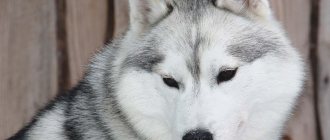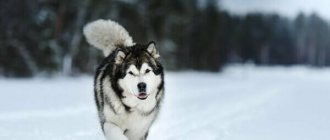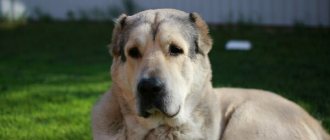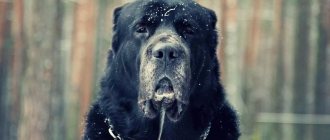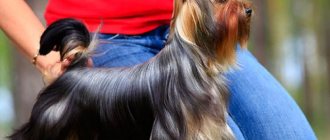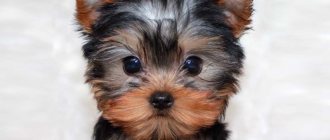Huskies were originally created to race across the icy expanses of the Far North, outrunning the wind.
Not surprisingly, the correct height to weight ratio is extremely important for these dogs.
After all, an overweight working husky would become exhausted too quickly, and a dog with excessively low body weight does not have sufficient strength and endurance.
A harmonious ratio of height and weight is extremely important for show dogs, since animals whose sizes do not correspond to the standard will not be highly appreciated in the ring and will not receive permission for breeding.
Height and weight
The weight of males should be from 20.5 to 28 kg, and that of females from 15.5 to 23 kg.
Height at the withers in adult representatives of the breed should be from 53.5 to 60 cm in males and from 50.5 to 56 cm in females.
The neck circumference of a husky is from 43 to 51 cm.
Considering that the body format of these dogs is only slightly stretched, the length of their body should exceed the height at the withers by no more than 1-3 cm.
Expert opinion
Tolkachev Andrey Mikhailovich
veterinarian
“The Husky's weight must be in the correct proportion to weight and within the standard range. Not all owners of these dogs feed their pets correctly and at the same time do not provide them with the necessary exercise. As a result, the husky quickly gains excess weight, which negatively affects not only his appearance, but also his health. "Obese dogs are more susceptible to diseases such as diabetes or heart disease, and for female dogs, being overweight can cause complications during pregnancy and childbirth."
Breed standard
The Siberian Husky is a medium-sized working dog. For hundreds of years it was used as a riding vehicle. Today this breed is very popular, and this is not surprising. Despite her powerful appearance, she is kind to children, affectionate, and very faithful to her owner.
An adult dog has a muscular body and strong bones. Males are seasoned and hardy, but are not distinguished by rudeness, females are graceful, although they have developed muscles.
What are the breed standards?
In dogs that are black, red and gray in color, the nose is black, in dogs of a copper shade it is chestnut, in snow-white dogs it is flesh-colored. The muzzle is average in length and width, becoming narrower closer to the ears. The lips are pigmented and fit tightly. The slightly slanted eyes of the husky are mesmerizing. Eye colors are brown and blue. The look of a dog of this breed is piercing, but friendly and not without a hint of mischief. The ears are medium in size, stand vertically upward, are close to each other, and have a triangular shape.
During the stance, the husky holds his head proudly raised. The beautiful curved neck gives the dog a proud posture. The back is straight. The tail is of the “fox” type, equally pubescent on all sides. When the dog is tense, the tail is raised and resembles a sickle. The coat is “double” of medium length. The coat is dense, but not long. When the dog moves, the tail does not curl to the side. Colors are allowed from black to snow-white. There may be markings and various patterns on the head.
Related article: How to distinguish a husky from a malamute and a samoyed
So, the main characteristics of the breed:
- the average size;
- proportionate strong body;
- correct tail;
- dense and coarse coat;
- friendly character;
- high degree of endurance.
Puppy weight and sizes from 1 to 12 months
The table shows the average size of a husky puppy by month.
| Husky puppy age | Weight | Height |
| 1 month | Weight - about 3 kg | Height - not measured |
| 2 months | Weight - 5-6 kg kg | Height - 31 cm |
| 3 months | Weight - 11.5 kg | Height - 43 cm |
| 4 months | Weight - 12-15 kg | Height - 47-48 cm |
| 5 months | Weight - 13-18 kg | Height - 48-52 cm |
| 6 months | Weight - 15.5-20.5 kg | Height - 49-54 cm |
| 7 months | Weight - 16.6-24 kg | Height - 51-57 cm |
| 8 months | Weight - 17.5-25 kg | Height - 53-58 cm |
| 9 months | Weight - 18.5-26.5 kg | Height - 53-58 cm |
| 10 months | Weight - 20-27 kg | Height - 53-58 cm |
| 11 months | Weight - 21-27.5 kg | Height - 54-59 cm |
| 1 year | Weight - 23-28 kg | Height - 54-59 cm |
Useful video
From the video you will learn everything about the Husky dog breed:
Rate the author's article:
6 ratings, average: 4.83 out of 5
Loading…
When purchasing husky puppies, some owners are completely unaware of what parameters their pet should have. However, to organize the correct diet, it is necessary to take into account the parameters of weight and height. In this article we will talk about how a husky puppy’s weight and size change over the months, and what they should be when the puppy turns one year old.
How to measure correctly?
Height should be measured by placing the pet on a flat, hard surface . It is very important that the husky stands still during measurements.
To do this, if the pet has already been trained for this, you can put it in a show rack or attract its attention by showing it a treat or toy.
Moreover, if the second method is chosen, then it is better to resort to the help of assistants from among relatives, since it will be difficult to independently hold the dog’s attention and measure it at the same time.
Next, you need to take a measuring tape or a special device for measuring a dog’s height, made from a long ruler and a limiter that can be moved along the entire length.
The centimeter must be applied with the edge with the smallest divisions to the animal’s withers, then pull the edge of the tape to the floor and mark the desired value below.
A height meter made from a ruler should be placed with one edge on the floor, and then the stop should be raised to the level of the pet’s withers.
It is more convenient to measure the growth of small puppies up to about three months of age on a table, but you need to make sure that the baby does not fall off it or jump onto the floor.
Proper education is the key to success
Huskies need to be trained from the first months. For example, the love of freedom of puppies leads to frequent escapes and, if the dog is not taught the appropriate command in time, you will have to constantly keep it on a leash. Call your baby to you, and as a reward for a successfully completed command, you can feed him dog delicacies.
Huskies need to be trained from the first months
With such hyperactivity, raising a husky puppy is not an easy task. It is important to accustom a growing pet to various stimuli that the urban environment is so rich in. The noise of cars, the screams of the crowd, the hum of the subway, other dogs - all this at first will be a kind of test for the dog. Walk him in different places - this will speed up the socialization process.
A common mistake that deserves special consideration is punishment for “wrong” actions. This method is especially harmful if you do not catch the dog damaging furniture, relieving itself in the wrong place, or running away. Use the reverse method of “reward” to reinforce positive qualities without reacting in any way to negative experiences. Husky training goes faster than you think, because they are one of the smartest dogs in the world.
The optimal basis for raising a husky is cognitive and educational games, which are carried out on special grounds or at home. With their help, you will establish communication with the dog and become the “leader of the pack.”
Training a husky puppy is also a scrupulous matter, and it must be done from the first months of life. By prohibiting or allowing the dog something, you form a certain pattern of behavior. This is especially necessary at home, when the husky has no contact with its relatives. Don't encourage your dog to beg, be lazy, or commit petty mischief, and you won't have to regret it when it grows up.
To what age do they grow?
Until six months of age, all puppies of this breed grow at approximately the same rate, but later their development acquires some differences, depending on the gender of the pet.
Bitches grow actively until about 8 months, after which the final growth spurt continues for up to a year . Weight and muscle mass continue to increase until approximately 2 years of age - until the dog is fully formed.
In males, the active growth phase is somewhat longer - up to approximately 9 months. Then, up to 1.5 years, the dog continues to develop, and is finally formed only by 2-3 years.
The bitch's growth may slow down with the onset of her first heat , but later it most often recovers and continues for several more months .
After a year
In a year, the formation of the husky is still ongoing. A fully formed pet can be observed between two and three years. The weight of an adult dog ranges from 15 to 28 kg. It is clear that a bitch should be more graceful than a dog. The height at the withers is 50.5–62 cm, and the length along the back to the base of the tail is 50–60 cm.
Husky average weight table by week.
The owner needs to take into account that the weight and height of a husky are average, so only significant deviations from the norm should be of concern.
Ultimately, the size of the dog will depend on feeding, health, and genetics. Note that proper nutrition and care in the first year of a puppy’s life determines how healthy the four-legged friend will be in the future.
What affects the parameters?
The height and weight of a husky puppy can depend on several reasons.:
- Heredity . It is she who determines to what age and how intensively the puppy will grow. In females, in addition, the age at which the first estrus occurs depends on the characteristics of the genotype - the period when active growth slows down or even stops, as happens in representatives of some lines.
- Quality of cultivation . How well the babies will grow and what size they will reach by the time of sale depends on what conditions were provided in the breeder’s home for the pregnant bitch and puppies.
- Feeding in a new home . For normal growth and weight gain, what and how correctly the new owner feeds his pet is of great importance. If the owner provides the baby with all the products he needs through natural feeding or feeds the puppy with high-quality complete food, he will grow well and gain weight. However, it should be taken into account that puppies raised on natural food initially grow at a faster rate than those fed with ready-made food.
- Conditions of detention. Puppies kept outdoors usually gain growth quite quickly, but due to the fact that they are constantly on the move, they can weigh less than dogs living in an apartment and not receiving intense physical exercise.
- Past illnesses . Those puppies who suffered from serious infectious diseases at an early age grow and gain weight worse than their peers.
- Physical activity . With increased physical activity, huskies gain less weight, but grow well in height. If growing puppies lead an inactive lifestyle, they may lag behind their peers in height, but at the same time have significantly more weight.
The rate of growth and weight gain may not depend on any of the above reasons and may be associated solely with the individual developmental characteristics of a particular puppy.
How much do husky puppies cost?
Prices vary from 20 to 80 thousand, depending on various factors.
How to choose?
You should choose for the soul, and not for external qualities. The puppy must suit your personality.
At what age should I take it?
A few days after the puppy becomes completely independent of its mother's milk. Usually this is 4–6 weeks.
How to determine age?
Based on a set of factors, such as height, weight, physique, behavior. From them you can roughly determine the age of the puppy.
Where is the best place to buy?
From trusted breeders on a personal visit. Where it is possible to determine living conditions, quality of food and treatment of animals. Find out more and see the puppy's mom and dad.
Who is better?
The best pet is the one that is loved. Girls are more active. They are more cunning and wayward than boys. Boys, on the contrary, are calmer and more devoted to their owner.
Price depending on type
There are only 5 types of huskies:
- Alaskan Husky (25–50 thousand rubles);
- Mini-husky (from 60 thousand rubles);
- Sakhalin Husky (20-30 thousand rubles);
- Siberian Husky (20-80 thousand rubles);
- Japanese husky (from 70 thousand rubles).
Purity of the breed
Determined by the absence of any defects and full compliance with the standard.
How to determine whether a husky or a crossbreed?
A purebred dog can be easily identified by its build, eye color, coat color and pedigree traits. Such as ear placement, tail position, etc.
How much does a purebred puppy cost?
A purebred puppy costs from 30 thousand rubles. and higher. The cost of a mixed breed usually does not exceed 20 thousand rubles.
Eye color
The breed is characterized by blue-eyed individuals. It is not uncommon to see dogs with different eyes . Also acceptable eye colors for the breed are amber, gray, and black.
Price with pedigree
The price tag for an individual with a pedigree starts from 50 thousand rubles, if there are titled parents. A puppy without documents will cost less than 20 thousand rubles .
average price
The average price for a representative of this breed in Russia is higher than abroad.
When choosing a husky, you should study in detail all the features of the breed, understand, first of all, for yourself, whether it suits your rhythm of life and whether you can satisfy all its needs, and not decide to take such a serious step just because of fashion.
What to do if your weight is below normal
It should be noted that the tables usually show the average height and weight characteristic of a particular age, and therefore there is no need to consider these parameters mandatory.
Therefore, if the puppy’s weight lags behind them by no more than 10%, then such an imaginary underweight should be considered a variant of the norm.
CAREFULLY!
In the same case, if there is a significant lag in weight, you need to try to quickly find out the reason for this.
Perhaps nothing terrible is happening and the lack of weight is due to the individual characteristics of the puppy. The baby simply grows very quickly in height and at the same time is distinguished by great mobility, which is why there is a lack of body weight.
In this case, you do not need to do anything, you just need to wait until the end of the active growth phase, after which the young dog will quickly gain the required weight.
The same applies to cases where underweight is due to heredity, when dogs from different lines grow faster or slower.
If underweight is associated with an incorrectly selected diet, then it is recommended to increase the amount of proteins and fats during natural feeding, and if the pet receives ready-made food, then try to choose a different brand for it with a higher nutritional value.
Vitamin and mineral supplements can also help, which, due to the beneficial microelements they contain, have an overall beneficial effect on the animal’s body..
In any case, before giving your husky any supplements, you should consult your veterinarian.
If we are talking not about puppies, but about adult dogs, then the problem of underweight can be solved by increasing the duration of walks and increased physical activity, including working in a harness.
Ready-made dog food
Recently, dog breeders are increasingly giving preference to commercially produced food. This type of nutrition is much more convenient than feeding with natural foods. With this choice, the owner will not have to study the components of each product or calculate the required dose of vitamins the pet receives.
In the process of preparing ready-made food, any needs of the dog are taken into account. The products of the German manufacturer Happy Dog are distinguished by their high quality and assortment for different types of animals. This product category is perfect for feeding active huskies.
Among the features of German food, one can highlight a unique formula, which contains:
- medicinal herbs (about 30);
- cereals with added enzyme;
- biologically active additives;
- flax seeds;
- fatty acid.
Happy Dog food contains no dyes, preservatives, or soy substitutes.
Among other premium foods, the following brands have good reviews:
- Purina Pro Plan;
- Nutra Gold;
- Royal Canin;
- Advance.
Of course, high-quality food is not very cheap, and can even put a significant dent in the pockets of some owners. But if a dog breeder really cares about his pet, the choice among the wide variety of ready-made food should still be made in favor of the above-mentioned manufacturers.
